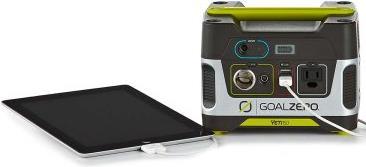
Goal Zero Yeti 150
5.40 kg

Goal Zero Yeti 150
5.40 kg
Yes, but the cables are not included.
Hello, only Galaxus can answer that, not a user, right?
I am not aware of this problem. Is it possible that the starting current is too high?
You can use any commercially available charger with a cigarette plug and the appropriate 8mm plug for the Yeti.
On my Yeti I have two Boulder panels running in parallel with 100 watts each, which means 200 watts in total. So far it's been running very well for about 6 months. But you have to pay attention to the polarity, and of course I have connected the two panels in parallel and not in series. If you exceed the maximum voltage, you will destroy your Yeti. The Boulder Solar Panel delivers 18-22 volts. If your panel is a 48 volt panel, it will not work. Generally speaking, it is the voltage that is critical, not the amperage. Volt times ampere = watt https://www.goalzero.com/shop/semi-portable-solar-panels/boulder-100-solar-panel/ https://www.goalzero.com/shop/power-stations/goal-zero-yeti-150-portable-power-station/ If your thing goes up in smoke, I don't give any guarantee! Lead-acid batteries are a bit outdated, but today I would rather choose a lithium battery. Because of the charging behaviour, the Ah value of lithium batteries is about twice that of lead batteries, i.e. a 10 Ah lithium battery is about the same as a 20 Ah lead battery. In addition, lithium batteries last much longer. With lithium-ion batteries, the number of charging cycles is usually between 4,000 and 7,000 cycles. Lead batteries often only deliver between 1,200 and 1,500 cycles. With lithium-ion storage batteries, the maximum depth of discharge is usually between 70-100%, with lead storage batteries only 50-60%. http://www.enersol.ch/uploads/files/Speicher%20Privat/AuswahlkriterienEuPD_2014.pdf
Wikipedia gives a good answer under the keywords 'Ohm's law' and 'lead accumulator'. Don't forget the ambient temperature. I myself need the Yeti to power a telescope with instruments and red light. It's a heavy pack compared to the Li-Ion power packs. I am happy with the Yeti, because I also have a solar panel from Goal Zero to charge the battery (for fun).
In principle, yes, in terms of technical data, e.g. voltage (12 volt input), but most other panels have a different connector (e.g. MC4). Zero Goal does not have a separate solar power input, but a round 8mm DC plug is required (same input as with charger). The adapter from Zero Goal, which connects between a panel cable with MC4 (2 x single-pole) and the Yeti, is currently not available anywhere. You can therefore use 2 adapters (e.g. car). A bit awkward. Depending on the panel, however, it can be worthwhile in terms of price. However, this is only in the planning stage for me. I am satisfied with the Yeti. I have already tried out a few devices on the AC output (small TV, massage chair, LED standing lamp). Everything runs well. Kind regards Tom
Apparently not. From http://www.goalzero.com/de/p/164/goal-zero-yeti-150-solar-generator/#tech-specs: Modified sine wave voltage inverters, like the ones used in the Yeti 150, are the most common inverters on the market. They work great with small electronics, usually anything that comes with an AC power cable, such as your laptop. Some or all of the following devices are not suitable for use in conjunction with a modified sine wave voltage inverter and should not be used with the Yeti 150. Such use is solely at the owner's risk and Goal Zero assumes no responsibility for any damage or injury caused by such use. Fluorescent lamps with dimmer function, electrical tools using thyristor energy or variable speed control, digital clocks with radios, and sewing machines with speed control.
Weight 5.4 kg Click on "Show more" for specifications
Basically, the Yeti 150 works with all devices that contain an AC power cable. This should normally be included with the printers. Neither I nor the manufacturer can answer how many sheets can be printed with a fully charged Yeti 150. As a general rule, one can say: All Goal Zero chargers have a number in their name. These numbers refer to watt-hours (Wh) or the amount of energy that can be stored in each individual battery, so you know if your equipment is compatible with that particular charger. For example, a 200 Wh battery should be able to power a 100 W lamp for 2 hours (200/100 = 2). If your equipment falls within the 150 Wh capacity of the Yeti 150, you should check the limitations on each output port. For more information, go to: http://www.goalzero.com/de/p/164/goal-zero-yeti-150-solar-generator/
13 of 13 questions